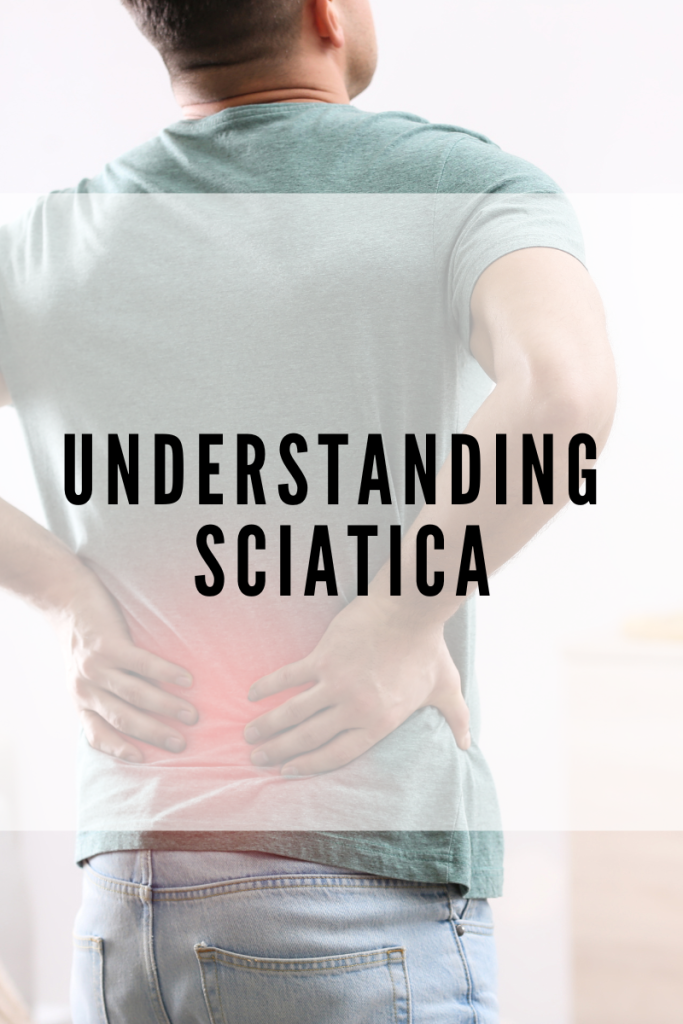Sciatica is a common condition that causes significant discomfort, impacting daily activities for many people. It involves pain that radiates along the sciatic nerve, which runs from the lower back, through the hips and buttocks, and down each leg. While sciatica can be a debilitating condition, understanding its symptoms, diagnosis, and management options—both self-managed and conservative—can offer relief and improve outcomes.
Symptoms of Sciatica
Sciatica typically presents with distinct symptoms, including:
- Radiating leg pain: The hallmark of sciatica is pain that starts in the lower back and radiates down the buttock and leg, often affecting one side of the body.
- Sharp, burning, or shooting pain: The pain is often described as sharp or burning, especially when sitting or standing for long periods.
- Numbness or tingling: Patients may feel a “pins and needles” sensation in the affected leg or foot.
- Weakness in the leg or foot: In more severe cases, muscle weakness in the leg or foot may develop, making it difficult to walk or stand.
- Worsened pain with movement: Pain may intensify with specific activities such as coughing, sneezing, or sudden movements.

Diagnosis of Sciatica
A proper diagnosis of sciatica involves a thorough clinical evaluation. Key steps in the diagnostic process include:
- Medical history: A comprehensive medical history helps assess the onset, duration, and severity of symptoms. Understanding prior injuries, lifestyle, and existing conditions also aids diagnosis.
- Physical examination: Tests such as the straight leg raise test, in which the leg is lifted while lying flat, can help assess the degree of nerve irritation.
- Imaging studies: In certain cases, imaging techniques such as X-rays, MRI, or CT scans may be used to evaluate the spine, detect disc herniation, or rule out other causes of sciatic pain, such as spinal stenosis or tumors.
Self-Management of Sciatica
For many, sciatica can be managed at home with a combination of lifestyle adjustments and targeted exercises. Some effective self-management strategies include:
- Rest and activity modification: Avoiding activities that worsen the pain, like heavy lifting or prolonged sitting, is key. However, excessive bed rest can prolong recovery, so maintaining a balance is crucial.
- Ice and heat therapy: Applying ice packs during the acute phase can reduce inflammation, while heat can help relax tight muscles once the initial pain subsides.
- Gentle stretches and mobility exercises: Specific stretches can help alleviate sciatic nerve tension. Hamstring stretches, piriformis stretches, and lower back mobility exercises are particularly helpful.
- Over-the-counter pain relievers: Non-steroidal anti-inflammatory drugs (NSAIDs), like ibuprofen, can temporarily reduce pain and inflammation.
- Posture correction: Proper posture when sitting, standing, and sleeping can help prevent further irritation to the sciatic nerve.
Conservative Management: Chiropractic Care, Dry Needling, and Rehabilitation
When self-management strategies are insufficient, conservative care options can provide significant relief. Chiropractic care, dry needling, and structured rehabilitation are non-invasive treatments that target the root cause of sciatica.
Chiropractic Care
Chiropractic treatment for sciatica focuses on spinal alignment and the reduction of nerve irritation. Common approaches include:
- Spinal adjustments: Chiropractic adjustments can help restore proper alignment of the vertebrae, reducing pressure on the sciatic nerve.
- Manual therapy: Techniques such as myofascial release or instrument-assisted soft tissue mobilization (IASTM) can address muscle tightness that may be contributing to sciatic symptoms.
- Lifestyle counseling: Chiropractors often provide advice on posture, ergonomics, and exercises to prevent recurrence.
Dry Needling
Dry needling is a technique used to target myofascial trigger points, or “knots” in the muscles, which can contribute to pain and nerve irritation. Dry needling involves inserting fine needles into these tight muscle areas, which can release tension, improve blood flow, and reduce pain. It’s particularly effective in addressing deep muscle tightness that may be aggravating the sciatic nerve.
Rehabilitation and Exercise Therapy
A structured rehabilitation program is essential for long-term recovery from sciatica. Key components of rehab include:
- Strengthening exercises: Strengthening the core, glutes, and leg muscles helps stabilize the spine and prevent recurrence. Exercises such as bridges, clamshells, and planks are commonly recommended.
- Stretching routines: Regular stretching of the hamstrings, lower back, and piriformis muscles can alleviate tension on the sciatic nerve.
- Postural training: Physical therapists work with patients to improve posture and correct movement patterns that may be contributing to their sciatica.
- Aerobic conditioning: Low-impact activities such as walking, swimming, or cycling can enhance cardiovascular health and aid in recovery.
Conclusion
Sciatica can be a painful and disruptive condition, but it can often be managed effectively with a combination of self-care and conservative treatments. Chiropractic care, dry needling, and rehabilitation offer excellent non-surgical solutions for alleviating symptoms and addressing the underlying causes. If you are experiencing persistent sciatic pain, seeking professional guidance is essential to creating a tailored treatment plan that promotes lasting relief.

Recent Comments